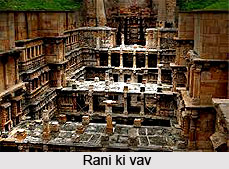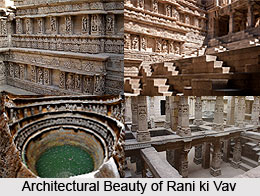 Rani ki vav is a magnificent stepwell structured with the excellent sculpture and architecture illustrated with Hindu mythological stories.
Rani ki vav is a magnificent stepwell structured with the excellent sculpture and architecture illustrated with Hindu mythological stories.
According to the history of Patan, Rani ki Vav was built in the memory of Bhimdev I, the ruler of Gujarat in the early medieval period. Patan was called as Anhilpur Patan when King Siddharja Jay Singh was ruling. During the rule of Solanki dynasty and Chalukya dynasty, the stepwell- Rani ki vav, or Ran-ki vav was constructed. It is a richly sculptured monument portraying the art and culture of Hindu mythological stories of Ramayana and Mahabharata.
Rani ki vav is generally assumed that it was built in the memory of Bhimdev I, the son of Mularaja, the founder of the Solanki dynasty of Anahilwada Pattan in about 1050 AD. It was built by his widowed queen Udayamati. This architectural splendour was probably completed by Karandev I after her death. In the year 1304 AD, Merunga Suri, a contemporary poet of that time carved the name of Udayamati, as she had the brainchild for constructing this sculptural brilliance.
Architecture of Rani ki Vav
Rani ki vav is an east facing monument, measures approximately 64m long, 20m wide and 27m deep. A stepped corridor compartmented of the stepwell at regular intervals with pillared multi-storeyed pavilions is a unique feature. It was one of the largest and the most sumptuous structures of its type in the early medieval period. It became silted up and much of it is not visible now, except for some rows of sculptured panels in the circular part of the well. Among its ruins one pillar still stands which is the proof not only of the elegance of its design, but also excellent example of this period of middle age. A part only of the west of Rani ki Vav is extant from which it appears that the wall had been built of brick and faced with stone. From this wall project vertical bracket in pairs, this supported the different galleries of the well shaft proper. This bracketing is arranged in tiers and is richly carved. The minute and exquisite carving of this "vav" is one of the finest specimens of its kind. Befitting its name, the Rani-Ki-Vav is now considered to be the Queen among step wells of India.

There is also a small gate below the last step of the stepwell which has a 30 kilometre tunnel built which leads to the town of Sidhpur near Patan. It was used as an escape gateway for king who built the step well in the times of defeat. Most of the sculptures are found in the portrayal of Lord Vishnu, in the forms of the different avatars of Indian mythology- Kalki, Rama, Mahisasurmardini, Narsingha, Vaman, Varaha and others representing their return to the world. The sculpture of beautiful celestial women like Apsara showcasing 16 different styles of make-up to look more attractive called Solah-Shringar. Previously near Rani ki Vav, the medicinal herbs grew, which causes the water accumulated in Rani ni vav helpful for viral disease, fever and other diseases.
Queen Udayamati commissioned this "vav" or stepwell, in 1063 in the memory of her husband King Bhimdev I of the Solanki dynasty. The "vav" was later flooded by the nearby Saraswati River and silted over until the late 1980s, when it was excavated by the Archeological Survey of India, with the carvings found in pristine condition. Rani Ki Vav in Patan is amongst the finest step wells in India.
Rani ki vav of Gujarat is not only served for collecting water and socialising, but also simultaneously hold great spiritual significance. In Rani ki Vav, there is a subterranean temple which had the spiritual significance at that time. The steps begin at ground level, leading one down through the cool air through several pillared pavilions to reach the deep well below. There are more than eight hundred intricate sculptures among seven galleries in Rani ki Vav. The sculptural designs are dedicated to the Hindu and Buddhist Gods and mythological stories.




